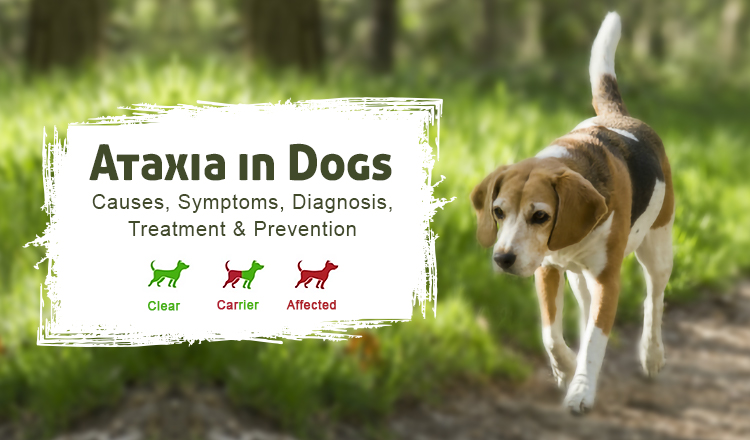What is Ataxia in Dogs?
Ataxia is a neurological condition in dogs which occurs as a result of improper coordination within the nervous system due to sensory dysfunction. This leads to abnormal movements of a dog’s legs, head, torso, or all three. So if a dog is suffering from ataxia it may appear unsteady while standing or walking as if it is drunk.
Causes and Symptoms of Ataxia in Dogs:
This neurological condition of unbalanced gait and uncoordinated movements arises due to dysfunction of three different anatomic regions and depending upon which of these three regions are affected.
There are Three Different Types of Ataxia as Follows:
1. Vestibular Ataxia
Vestibular Ataxia occurs as a result of improper functioning of the inner ear or the brainstem. This disturbs the coordination of nerve signals regarding balance.
Causes: Nerve degeneration, injury in the ear or head, fungal infections, poisoning, adverse reaction to antibiotics, cancer, hypothyroidism, immune disorders, infections with viruses like canine distemper virus, etc.
Symptoms: Loss of Balance and improper positioning of head.
Also Read: Cancer in Dogs – Types, Symptoms and Treatment
2. Proprioception Ataxia
Proprioception is the unconscious awareness of the body. It means being aware of where your limbs are. Proprioception ataxia occurs as a result of lack of proprioception.
Causes: Lack of proprioception mainly occurs as a result of pressure on the spinal cord due to bulging of intervertebral disc or tumor. It may also occur as a result of trauma, injury, degeneration of spinal cord tissue, infection or inflammation in spine, bleeding blood vessels in spinal cord, nerve conduction issues, blood clot, cysts, etc.
Symptoms: Loss of awareness about limbs, unbalanced gait, etc.
3. Cerebellar Ataxia
Cerebellar ataxia results due to damage in cerebellum. The cerebellum is a part of brain responsible for coordination and movement. When cerebellum is damaged, these functions are disturbed.
Causes: Infection, tumors or inflammation in brain; congenital factors like abnormal skull anatomy or hereditary, cellular degeneration in cerebellum, antibiotic toxicity, etc.
Symptoms: When a dog is suffering from cerebellar ataxia it may show abnormal and exaggerated limb movements while moving but it may appear completely normal while resting. Unusual eye and head movements and tremors may also be noticed. Cerebellar ataxia is sometimes muddled with stroke due to similarity in the symptoms.
Also Read: 6 Most Common Dog Diseases
Diagnosis of Ataxia in Dogs:
As we discussed earlier, ataxia does not have one single root cause and therefore, there isn’t a single protocol to diagnose ataxia. It has to be diagnosed depending upon the type, symptoms and root cause.
If you notice sudden abnormal gait, or odd head and eye movements take it to a veterinarian. Don’t forget to tell the vet about all the symptoms that you’ve noticed.
A dog suffering from ataxia may sometimes show behavioral issues when taken to the vet. An experienced veterinarian will check for all the abnormalities which may include observation of the dog while standing, walking, climbing stairs with all the safety measures.
After observing the vet may assume the type of ataxia and suggest some tests depending on that.
The diagnosis can only be concluded after physical tests like neurological and limb sensitivity tests; and imaging tests X-rays of spinal cord, Radiographs, Magnetic Resonance Imaging (MRI of brain), etc.
Treatment of Ataxia in Dogs:
The treatment of ataxia depends upon a lot of factors like the type of ataxia, areas affected, severity of the disease, age of the pet, etc.
There isn’t any specific treatment for ataxia but it is mostly pain management treatments to relieve the symptoms.
Causes like tumors or cancer are often cured by chemotherapy, surgery, and radiation therapies. Unfortunately, hereditary causes are incurable, but however, providing supportive care and a safe environment.
Cordoning off the stairs and dangerous areas of the house can help a lot in creating a safe environment. Dogs with ataxia too can live a good life if provided proper supportive care.
Prevention of Ataxia in Dogs:
Sad to say that there’s no way by which one can secure their dog from ataxia. There are no preventive steps but you can decrease the probability of it occurring by toxicities, injuries, or other diseases. To prevent vestibular ataxia due to infections, it is advisable to keep your dog’s ears clean with Ear Care products like:

Epi Otic Ear Cleaner

Otosol Ear Drops

Cleanaural Ear Cleaner

Malacetic Otic Ear Cleaner
Moreover, in order to keep a dog healthy always feed your dog good nutritionally balanced food, and provide them with Nutritional Supplements if required.





